目录
@Repository、@Service、@Controller
依赖注入
三种依赖注入的方式:
Setter依赖注入
配置文件中,给需要注入属性值的<bean>中设置<property>
1、创建持久层接口和持久层接口实现类和POJO类
public interface StudentDao {
// 根据id查询学生
Student findById(int id);
}
public class StudentDaoImpl implements StudentDao {
@Override
public Student findById(int id) {
return new Student(1,"路飞",16,"男");
}
}
public class Student {
private int sid;
private String sname;
private int age;
private String sex;
public Student(int sid, String sname, int age, String sex) {
this.sid = sid;
this.sname = sname;
this.age = age;
this.sex = sex;
}
public Student() {
}
public int getSid() {
return sid;
}
public void setSid(int sid) {
this.sid = sid;
}
public String getSname() {
return sname;
}
public void setSname(String sname) {
this.sname = sname;
}
public int getAge() {
return age;
}
public void setAge(int age) {
this.age = age;
}
public String getSex() {
return sex;
}
public void setSex(String sex) {
this.sex = sex;
}
@Override
public String toString() {
return "Student{" +
"sid=" + sid +
", sname='" + sname + '\'' +
", age=" + age +
", sex='" + sex + '\'' +
'}';
}
}
2、创建逻辑层
这个逻辑层中有一个StudentDao类型的属性,一定要为这个属性创建getter、setter方法
package com.itbaizhan.service;
import com.itbaizhan.dao.StudentDao;
import com.itbaizhan.pojo.Student;
import java.util.List;
import java.util.Map;
import java.util.Properties;
import java.util.Set;
public class StudentService {
private StudentDao studentDao; // bean属性
private String name; //字符串类型
private int count; //基本数据类型
private List<String> names; // 字符串类型List集合
private List<Student> students1; // 对象类型List集合
private Set<Student> students2; // 对象类型Set集合
private Map<String,String> names2; // 字符串类型Map集合
private Map<String,Student> students3; // 对象类型Map集合
private Properties properties; //Properties类型
public StudentDao getStudentDao() {
return studentDao;
}
public void setStudentDao(StudentDao studentDao) {
this.studentDao = studentDao;
}
public String getName() {
return name;
}
public void setName(String name) {
this.name = name;
}
public int getCount() {
return count;
}
public void setCount(int count) {
this.count = count;
}
public List<String> getNames() {
return names;
}
public void setNames(List<String> names) {
this.names = names;
}
public List<Student> getStudents1() {
return students1;
}
public void setStudents1(List<Student> students1) {
this.students1 = students1;
}
public Set<Student> getStudents2() {
return students2;
}
public void setStudents2(Set<Student> students2) {
this.students2 = students2;
}
public Map<String, String> getNames2() {
return names2;
}
public void setNames2(Map<String, String> names2) {
this.names2 = names2;
}
public Map<String, Student> getStudents3() {
return students3;
}
public void setStudents3(Map<String, Student> students3) {
this.students3 = students3;
}
public Properties getProperties() {
return properties;
}
public void setProperties(Properties properties) {
this.properties = properties;
}
public Student findById(int id){
return studentDao.findById(id);
}
@Override
public String toString() {
return "StudentService{" +
"studentDao=" + studentDao +
", name='" + name + '\'' +
", count=" + count +
", names=" + names +
", students1=" + students1 +
", students2=" + students2 +
", names2=" + names2 +
", students3=" + students3 +
", properties=" + properties +
'}';
}
}
3、编写bean.xml文件
<!--name:对象的属性名 ref:容器中对象的id值-->
<?xml version="1.0" encoding="UTF-8"?>
<beans xmlns="http://www.springframework.org/schema/beans"
xmlns:context="http://www.springframework.org/schema/context"
xmlns:xsi="http://www.w3.org/2001/XMLSchema-instance"
xsi:schemaLocation="http://www.springframework.org/schema/beans
http://www.springframework.org/schema/beans/spring-beans.xsd
http://www.springframework.org/schema/context
http://www.springframework.org/schema/context/spring-context.xsd">
<bean id="studentDaoImpl" class="com.itbaizhan.dao.StudentDaoImpl"></bean>
<bean id="studentService" class="com.itbaizhan.service.StudentService">
<!-- 使用setter方法实现依赖注入 -->
<property name="studentDao" ref="studentDaoImpl"></property>
</bean>
</beans>4、测试
public class TestContainer {
@Test
public void t1(){
//创建Spring容器
ApplicationContext ac = new ClassPathXmlApplicationContext("bean.xml");
//获取对象
StudentService studentService = (StudentService) ac.getBean("studentService");
System.out.println(studentService.findById(1));
}
}
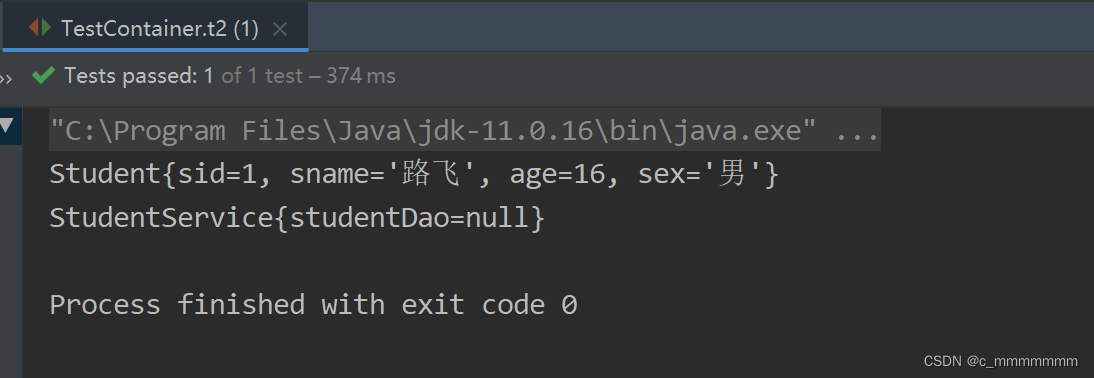
构造方法依赖注入
给需要注入属性值的<bean>中设置<constructor-arg>
持久层接口和实现类和POJO类和Service类和测试类都延续上面的
bean.xml文件需要重新编写,将property标签改为constructor-arg标签,对应的被注入类需要添加构造方法
<bean id="studentDaoImpl" class="com.itbaizhan.dao.StudentDaoImpl"></bean>
<bean id="studentService" class="com.itbaizhan.service.StudentService">
<!-- 使用constructor方法实现依赖注入 -->
<constructor-arg name="studentDao" ref="studentDaoImpl"></constructor-arg>
</bean>测试:
public class TestContainer {
@Test
public void t1(){
//创建Spring容器
ApplicationContext ac = new ClassPathXmlApplicationContext("bean.xml");
//获取对象
StudentService studentService = (StudentService) ac.getBean("studentService");
System.out.println(studentService.findById(1));
}
}

自动注入
自动注入不需要在<bean>标签中添加其他标签注入属性值,而是自动从容器中找到相应的bean对象设置为属性值。
自动注入有两种配置方式:
- 全局配置:在<beans>中设置default-autowire属性可以定义所有bean对象的自动注入策略。
- 局部配置:在<bean>中设置autowire属性可以定义当前bean对象的自动注入策略。
autowire的取值如下:
- no:不会进行自动注入。
- default:全局配置default相当于no,局部配置default表示使用全局配置
- byName:在Spring容器中查找id与属性名相同的bean,并进行注入。需要提供set方法。
- byType:在Spring容器中查找类型与属性类型相同的bean,并进行注入。需要提供set方法。
- constructor:在Spring容器中查找id与属性名相同的bean,并进行注入。需要提供构造方法。
只需要修改bean.xml配置文件即可
<bean id="studentDao" class="com.itbaizhan.dao.StudentDaoImpl"></bean>
<!-- 使用自动注入实现依赖注入 -->
<bean id="studentService" class="com.itbaizhan.service.StudentService" autowire="byName"></bean>测试
public class TestContainer {
@Test
public void t1(){
//创建Spring容器
ApplicationContext ac = new ClassPathXmlApplicationContext("bean.xml");
//获取对象
StudentService studentService = (StudentService) ac.getBean("studentService");
System.out.println(studentService.findById(1));
}
}
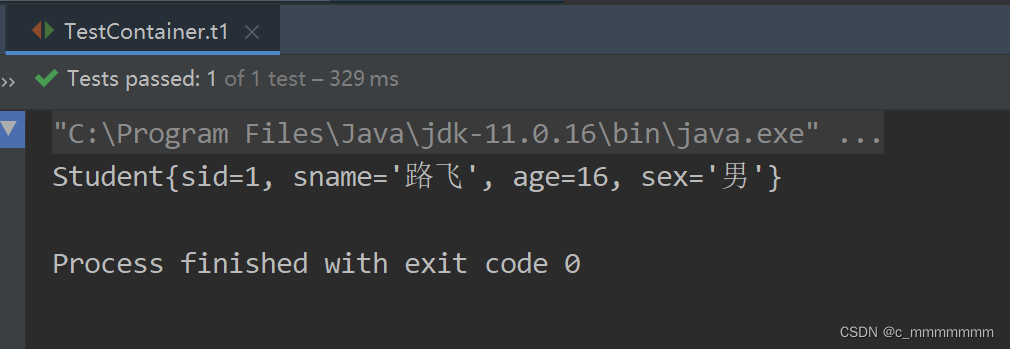
注入bean类型
使用property标签
name:对象的属性名 ref:容器中对象的id值
第一种:
<bean id="studentDaoImpl" class="com.itbaizhan.dao.StudentDaoImpl"></bean>
<bean id="studentService" class="com.itbaizhan.service.StudentService">
<!-- 使用setter方法实现依赖注入 -->
<property name="studentDao" ref="studentDaoImpl"></property>
</bean>第二种:
<bean id="studentDaoImpl" class="com.itbaizhan.dao.StudentDaoImpl"></bean>
<bean id="studentService" class="com.itbaizhan.service.StudentService">
<!-- 使用setter方法实现依赖注入 -->
<property name="studentDao">
<ref bean="studentDaoImpl"></ref>
</property>
</bean>注入基本数据类型、字符串类型
使用value标签
name:属性名 value:属性值
<bean id="studentDaoImpl" class="com.itbaizhan.dao.StudentDaoImpl"></bean>
<bean id="studentService" class="com.itbaizhan.service.StudentService">
<!-- 注入bean类型 -->
<property name="studentDao" ref="studentDaoImpl"></property>
<!-- 注入基本数据类型或字符串 -->
<property name="name" value="路飞"></property>
</bean>测试
public class TestContainer {
@Test
public void t1(){
//创建Spring容器
ApplicationContext ac = new ClassPathXmlApplicationContext("bean.xml");
//获取对象
StudentService studentService = (StudentService) ac.getBean("studentService");
System.out.println(studentService);
}
}

注入list、set
根据StudentService类我们可以看到有List、Set类型的属性
package com.itbaizhan.service;
import com.itbaizhan.dao.StudentDao;
import com.itbaizhan.pojo.Student;
import java.util.List;
import java.util.Map;
import java.util.Properties;
import java.util.Set;
public class StudentService {
private StudentDao studentDao; // bean属性
private String name; //字符串类型
private int count; //基本数据类型
private List<String> names; // 字符串类型List集合
private List<Student> students1; // 对象类型List集合
private Set<Student> students2; // 对象类型Set集合
private Map<String,String> names2; // 字符串类型Map集合
private Map<String,Student> students3; // 对象类型Map集合
private Properties properties; //Properties类型
public StudentDao getStudentDao() {
return studentDao;
}
public void setStudentDao(StudentDao studentDao) {
this.studentDao = studentDao;
}
public String getName() {
return name;
}
public void setName(String name) {
this.name = name;
}
public int getCount() {
return count;
}
public void setCount(int count) {
this.count = count;
}
public List<String> getNames() {
return names;
}
public void setNames(List<String> names) {
this.names = names;
}
public List<Student> getStudents1() {
return students1;
}
public void setStudents1(List<Student> students1) {
this.students1 = students1;
}
public Set<Student> getStudents2() {
return students2;
}
public void setStudents2(Set<Student> students2) {
this.students2 = students2;
}
public Map<String, String> getNames2() {
return names2;
}
public void setNames2(Map<String, String> names2) {
this.names2 = names2;
}
public Map<String, Student> getStudents3() {
return students3;
}
public void setStudents3(Map<String, Student> students3) {
this.students3 = students3;
}
public Properties getProperties() {
return properties;
}
public void setProperties(Properties properties) {
this.properties = properties;
}
public Student findById(int id){
return studentDao.findById(id);
}
@Override
public String toString() {
return "StudentService{" +
"studentDao=" + studentDao +
", name='" + name + '\'' +
", count=" + count +
", names=" + names +
", students1=" + students1 +
", students2=" + students2 +
", names2=" + names2 +
", students3=" + students3 +
", properties=" + properties +
'}';
}
}
1、property标签使用list标签注入list集合
注入简单数据类型list集合
<bean id="studentDaoImpl" class="com.itbaizhan.dao.StudentDaoImpl"></bean>
<bean id="studentService" class="com.itbaizhan.service.StudentService">
<!-- 注入bean类型 -->
<property name="studentDao" ref="studentDaoImpl"></property>
<!-- 注入基本数据类型或字符串 -->
<property name="name" value="路飞"></property>
<property name="count" value="1"></property>
<!-- 注入简单数据类型list -->
<property name="names">
<list>
<value>索隆</value>
<value>乔巴</value>
</list>
</property>
</bean>测试:
public class TestContainer {
@Test
public void t1(){
//创建Spring容器
ApplicationContext ac = new ClassPathXmlApplicationContext("bean.xml");
//获取对象
StudentService studentService = (StudentService) ac.getBean("studentService");
System.out.println(studentService);
}
}

注入bean类型list集合
<bean id="studentDaoImpl" class="com.itbaizhan.dao.StudentDaoImpl"></bean>
<bean id="studentService" class="com.itbaizhan.service.StudentService">
<!-- 注入bean类型 -->
<property name="studentDao" ref="studentDaoImpl"></property>
<!-- 注入基本数据类型或字符串 -->
<property name="name" value="路飞"></property>
<property name="count" value="1"></property>
<!-- 注入简单数据类型list -->
<property name="names">
<list>
<value>索隆</value>
<value>乔巴</value>
</list>
</property>
<!-- 注入bean类型list -->
<property name="students1">
<list>
<bean class="com.itbaizhan.pojo.Student">
<property name="sid" value="1"></property>
<property name="sname" value="索隆"></property>
<property name="sex" value="男"></property>
<property name="age" value="16"></property>
</bean>
<bean class="com.itbaizhan.pojo.Student">
<property name="sid" value="1"></property>
<property name="sname" value="娜美"></property>
<property name="sex" value="女"></property>
<property name="age" value="20"></property>
</bean>
</list>
</property>
</bean>测试
public class TestContainer {
@Test
public void t1(){
//创建Spring容器
ApplicationContext ac = new ClassPathXmlApplicationContext("bean.xml");
//获取对象
StudentService studentService = (StudentService) ac.getBean("studentService");
System.out.println(studentService);
}
}

注入map
简单数据类型Map集合:
<bean id="studentService" class="com.itbaizhan.service.StudentService">
<!-- 简单数据类型map集合 name:属性名 -->
<property name="names2">
<map>
<entry key="student1" value="bz"/>
<entry key="student2" value="sxt"/>
</map>
</property>
</bean>
对象类型Map集合:
<bean id="studentService" class="com.itbaizhan.service.StudentService">
<!-- 对象类型map集合 name:属性名 -->
<property name="students3">
<map>
<entry key="student1" value-ref="s1"/>
<entry key="student2" value-ref="s2"/>
</map>
</property>
</bean>
<bean id="s1" class="com.itbaizhan.domain.Student">
<property name="id" value="1"/>
<property name="name" value="尚学堂"/>
<property name="address" value="北京"/>
</bean>
<bean id="s2"class="com.itbaizhan.domain.Student">
<property name="id" value="2"/>
<property name="name" value="百战"/>
<property name="address" value="北京"/>
</bean>注入Properties对象
注入Properties对象
<bean id="studentService" class="com.itbaizhan.service.StudentService">
<property name="properties">
<props>
<prop key="配置1">值1</prop>
<prop key="配置2">值2</prop>
</props>
</property>
</bean>注解实现IOC
准备工作
注解配置和xml配置对于Spring的IOC要实现的功能都是一样的,只是配置的形式不一样。
- 创建一个新的Spring项目。
- 编写pojo,dao,service类。
- 编写空的配置文件,如果想让该文件支持注解,需要添加新的约束:
<?xml version="1.0" encoding="UTF-8"?>
<beans xmlns="http://www.springframework.org/schema/beans"
xmlns:context="http://www.springframework.org/schema/context"
xmlns:xsi="http://www.w3.org/2001/XMLSchema-instance"
xsi:schemaLocation="http://www.springframework.org/schema/beans
http://www.springframework.org/schema/beans/spring-beans.xsd
Index of /schema/context
http://www.springframework.org/schema/context/spring-context.xsd">
</beans>
@Component
作用:用于创建对象,放入Spring容器,相当于<bean id="" class="">
位置:类上方
@Component
public class StudentService {
private StudentDao studentDao;
public StudentDao getStudentDao() {
return studentDao;
}
public void setStudentDao(StudentDao studentDao) {
this.studentDao = studentDao;
}
public StudentService(StudentDao studentDao) {
this.studentDao = studentDao;
}
public StudentService() {
}
}
测试:
public class TestContainer {
@Test
public void t1(){
//创建Spring容器
ApplicationContext ac = new ClassPathXmlApplicationContext("bean.xml");
//获取对象
StudentService studentService = (StudentService) ac.getBean("studentService");
System.out.println(studentService);
}
}
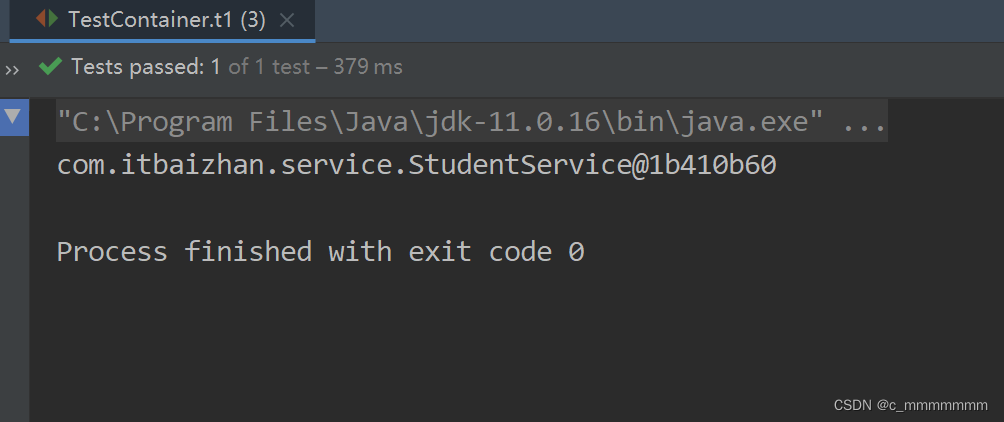
注意:
- 要在配置文件中配置扫描的包,扫描到该注解才能生效。
<context:component-scan base-package="com.itbaizhan"></context:component-scan> - @Component注解配置bean的默认id是首字母小写的类名。
也可以手动设置bean的id值。
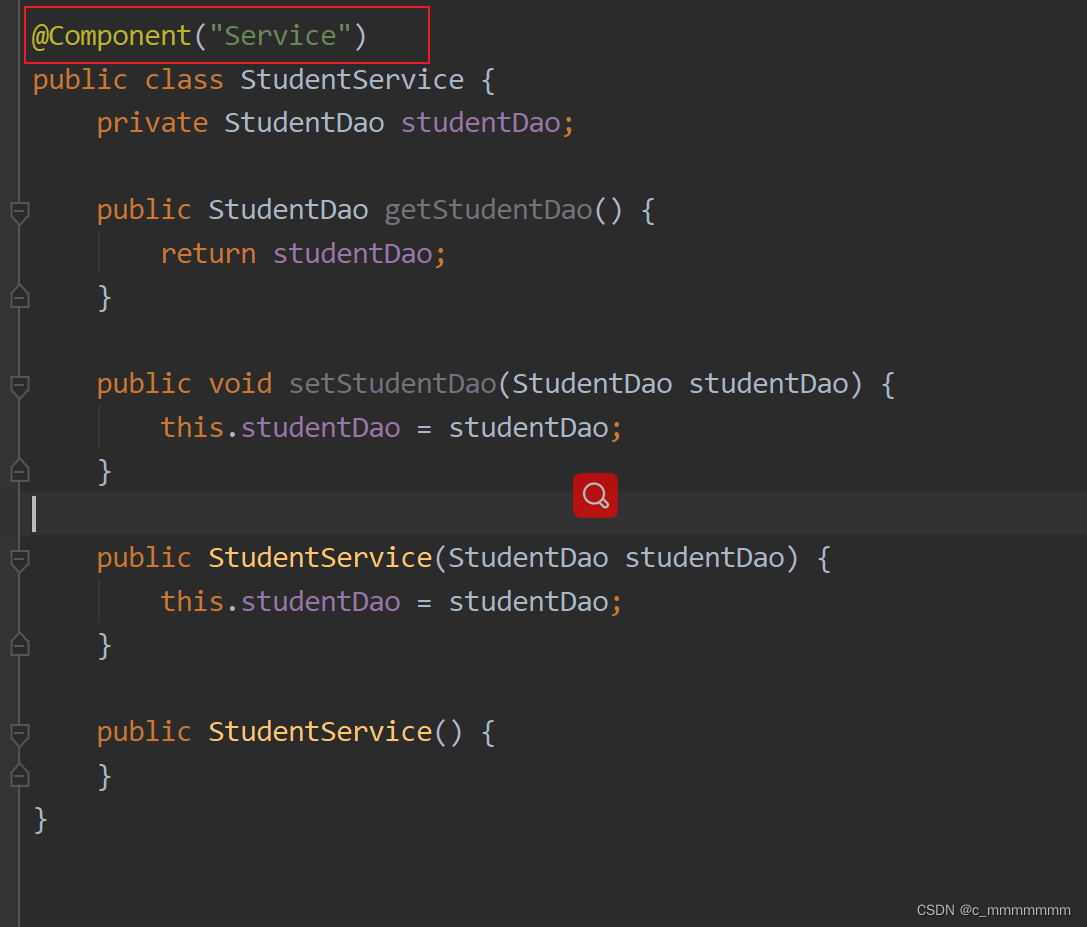
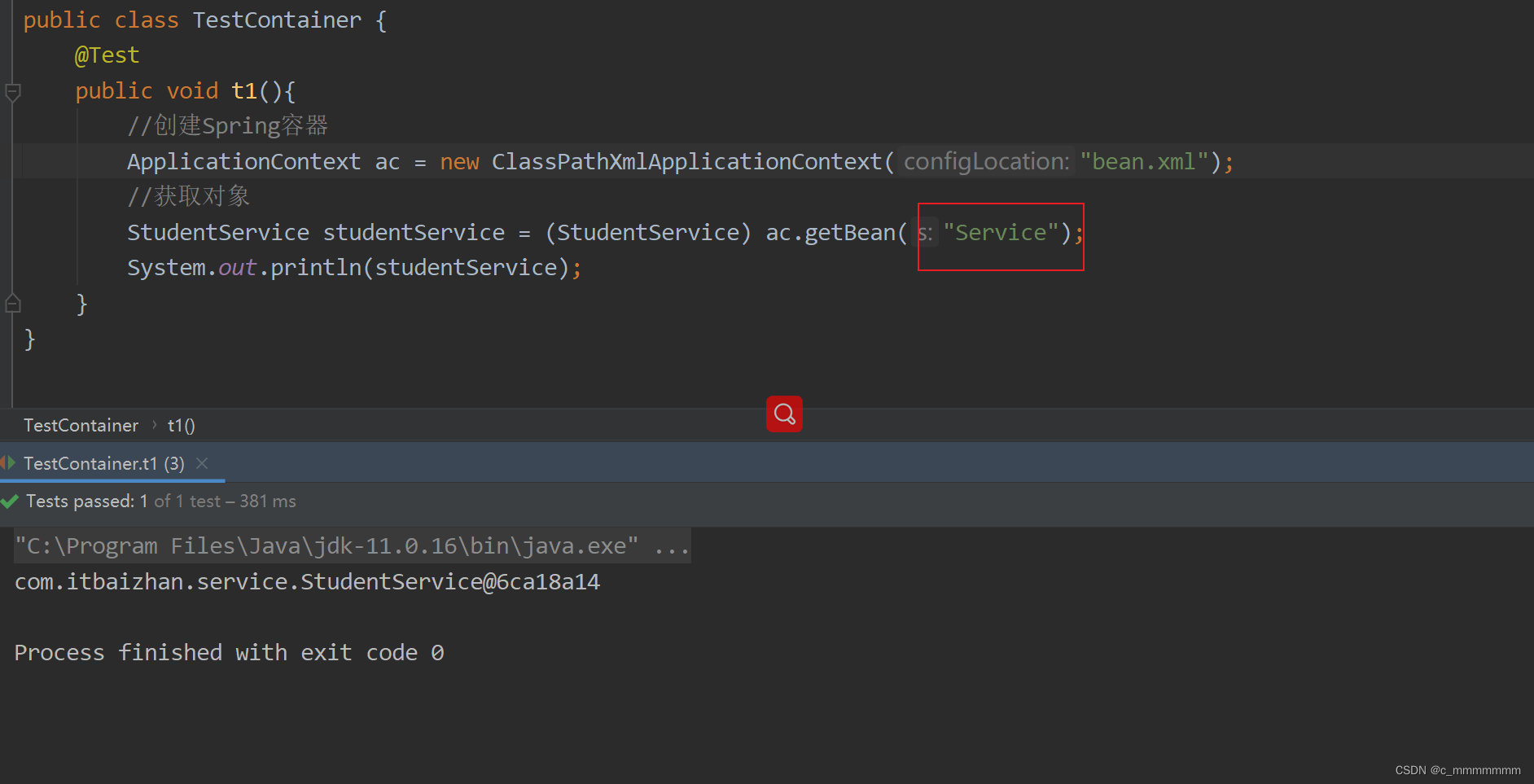
@Repository、@Service、@Controller
作用:这三个注解和@Component的用法和作用一样,
使用它们是为了区分该类属于什么层。
位置:
- @Repository用于Dao层
- @Service用于Service层
- @Controller用于Controller层
@Scope
作用:指定bean的创建策略
位置:类上方
取值:
singleton
prototype
request
session
globalsession
@Autowried
作用:从容器中查找符合属性类型的对象自动注入属性中。用于代替<bean>中的依赖注入配置。
位置:属性上方、setter方法上方、构造方法上方。
注意:
- @Autowired写在属性上方进行依赖注入时,可以省略setter方法
@Component("Service")
public class StudentService {
@Autowired
private StudentDao studentDao;
public StudentDao getStudentDao() {
return studentDao;
}
public void setStudentDao(StudentDao studentDao) {
this.studentDao = studentDao;
}
public StudentService(StudentDao studentDao) {
this.studentDao = studentDao;
}
public StudentService() {
}
@Override
public String toString() {
return "StudentService{" +
"studentDao=" + studentDao +
'}';
}
}
测试
public class TestContainer {
@Test
public void t1(){
//创建Spring容器
ApplicationContext ac = new ClassPathXmlApplicationContext("bean.xml");
//获取对象
StudentService studentService = (StudentService) ac.getBean("Service");
System.out.println(studentService);
}
}

2. 容器中没有对应类型的对象会报错
// 如果StudentDaoImpl没有放到容器中会报错
//@Component("studentDao")
public class StudentDaoImpl implements StudentDao{
public StudentfindById(int id) {
// 模拟根据id查询学生
return new Student(1,"百战程序员","北京");
}
}
3. 容器中有多个对象匹配类型时,会找beanId等于属性名的对象,找不到会报错。
// 如果容器中都多个同类型对象,会根据id值等于属性名找对象
@Component("studentDao")
public class StudentDaoImpl implements StudentDao{
public Student findById(int id) {
// 模拟根据id查询学生
return new Student(1,"百战程序员","北京");
}
}
@Component
public class StudentDaoImpl2 implements StudentDao{
public Student findById(int id) {
// 模拟根据id查询学生
return new Student(1,"百战程序员","北京");
}
}
@Qualifier
作用:在按照类型注入对象的基础上,再按照bean的id注入。
位置:属性上方
注意:@Qualifier必须和@Autowired一起使用。
@Component
public class StudentService{
@Autowired
@Qualifier("studentDaoImpl2")
private StudentDao studentDao;
public Student findStudentById(int id){
return student Dao.findById(id);
}
}@Value
作用:注入String类型和基本数据类型的属性值。
位置:属性上方
用法:
直接设置固定的属性值
@Service
public class StudentService{
@Value("1")
private int count;
@Value("hello")
private String str;
}@Configuration
bean.xml,使用纯注解实现IOC。
在真实开发中,我们一般还是会保留xml配置文件,很多情况下使用配置文件更加方便。
纯注解实现IOC需要一个Java类代替xml文件。这个Java类上方需要添加@Configuration,表示该类是一个配置类,作用是代替配置文件。
@Configuration
public class SpringConfig{
}@ComponentScan
作用:指定spring在初始化容器时扫描的包。
位置:配置类上方
@Configuration
@ComponentScan("com.itbaizhan")
public class SpringConfig{
}@PropertySource
作用:代替配置文件中的<context:property-placeholder>扫描配置文件
位置:配置类上方
注意:配置文件位置前要加关键字classpath
@Configuration
@PropertySource("classpath:db.properties")
public class SpringConfig{
}@Bean
作用:将方法的返回值对象放入Spring容器中。如果想将第三方类的对象放入容器,可以使用@Bean
位置:配置类的方法上方。
属性:name:给bean对象设置id
注意:@Bean修饰的方法如果有参数,spring会根据参数类型从容器中查找可用对象。
举例:如果想将jdbc连接对象放入Spring容器,我们无法修改Connection源码添加@Component,此时就需要使用将@Bean该对象放入Spring容器
1. 添加驱动依赖
<dependency>
<groupId>mysql</groupId>
<artifactId>mysql-connector-java</artifactId>
<version>8.0.27</version>
</dependency>
2. 将Connection对象放入Spring容器
@Bean(name="connection")
public Connection getConnection(){
try{
Class.forName("com.mysql.cj.jdbc.Driver");
return DriverManager.getConnection("jdbc:mysql:///mysql", "root", "root");
} catch(Exceptionexception) {
return null;
}
}
@Import
作用:如果配置过多,会有多个配置类,该注解可以为主配置类导入其他配置类
位置:主配置类上方
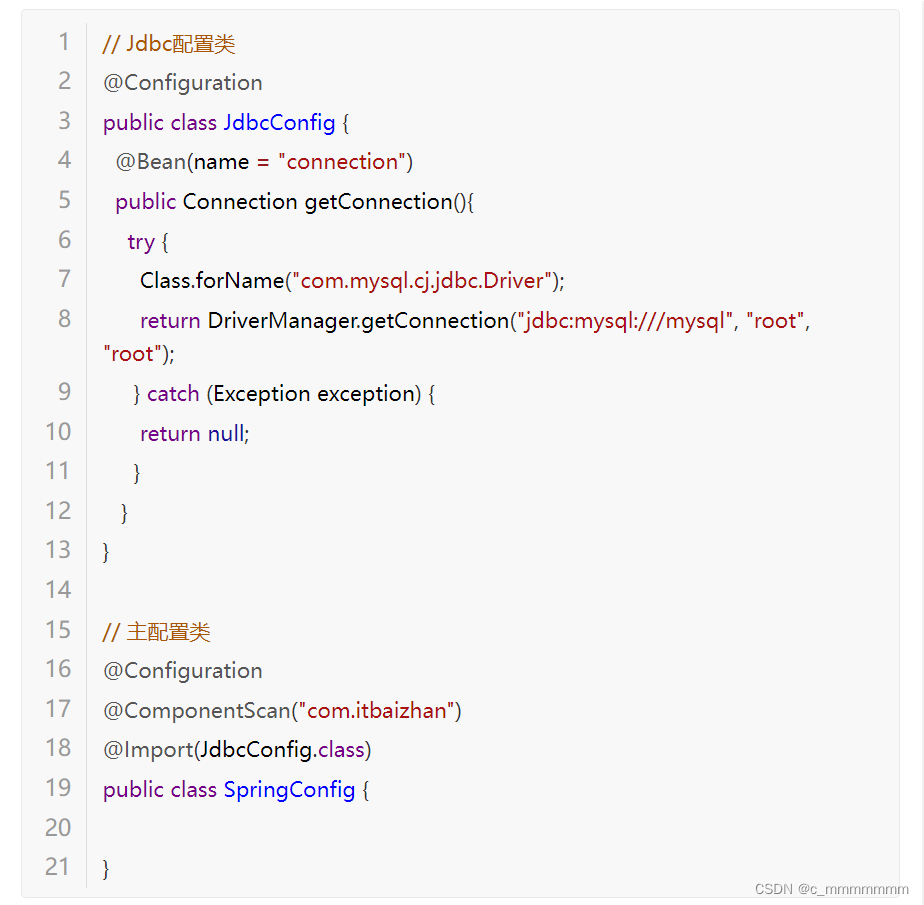





















 3416
3416











 被折叠的 条评论
为什么被折叠?
被折叠的 条评论
为什么被折叠?








